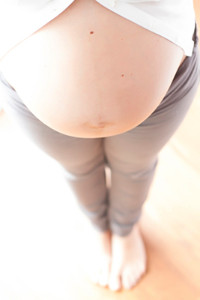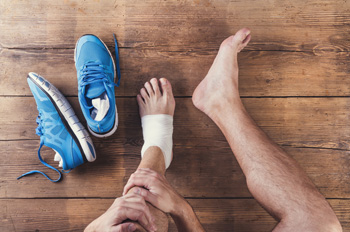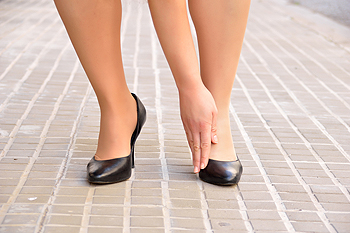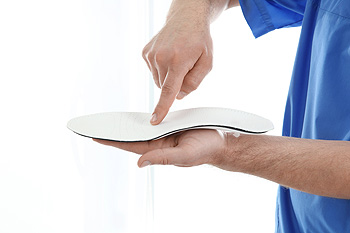159 North 3rd Street
Macclenny, Florida 32063

Blisters are pockets of fluid that occur under the top layer of your skin. These fluid pockets are usually filled with pus, blood, or serum. Blisters may itch or hurt and can appear as a single bubble or in clusters.
The most common types of blisters are friction blisters. This type of blister may be caused by wearing shoes that are too tight. Friction blisters can also occur on the hands. A change in temperature may also cause blisters on the feet. In the freezing air, frostbite on your toes can lead to blisters, as well as sunburn from hot weather.
The best way to treat a blister is to keep it clean and dry. Most blisters will get better on their own. Once the skin absorbs the fluid within the blister, it will flatten and eventually peel off. You should avoid popping your blister unless you podiatrist does it for you. Additional treatment options include applying an ice pack to the blister or using over-the-counter blister bandages to cover the affected area.
If your blister becomes discolored, inflamed, or worsens it is advised that you speak to your podiatrist. Blisters that are yellow, green, or purple may be infected and require immediate medical attention. Blisters that are abnormally colored may be a sign of a more serious underlying health condition such as herpes.
 When a woman discovers she is pregnant, there are many changes that normally take place over the next nine months and thereafter. Experiencing foot pain during pregnancy is common, and this can produce discomfort while standing. Swelling may accompany foot pain, which may make it difficult to perform daily tasks. There may be several reasons why foot pain may be apparent during pregnancy, including extra pressure the feet must endure from the additional weight gain, a natural change in posture as a result of the center of gravity shifting in the body, in addition to the blood becoming thicker, possibly causing uncomfortable foot cramps. There may be gentle exercises that can be performed, which may provide the desired relief from pregnancy foot pain. Additionally, drinking plenty of fresh water, limiting salt intake, and eating a balanced diet may aid in the reduction of foot pain that is associated with pregnancy. If you would like additional information about techniques that may avoid foot pain during this time in your life, it is advised to speak with a podiatrist.
When a woman discovers she is pregnant, there are many changes that normally take place over the next nine months and thereafter. Experiencing foot pain during pregnancy is common, and this can produce discomfort while standing. Swelling may accompany foot pain, which may make it difficult to perform daily tasks. There may be several reasons why foot pain may be apparent during pregnancy, including extra pressure the feet must endure from the additional weight gain, a natural change in posture as a result of the center of gravity shifting in the body, in addition to the blood becoming thicker, possibly causing uncomfortable foot cramps. There may be gentle exercises that can be performed, which may provide the desired relief from pregnancy foot pain. Additionally, drinking plenty of fresh water, limiting salt intake, and eating a balanced diet may aid in the reduction of foot pain that is associated with pregnancy. If you would like additional information about techniques that may avoid foot pain during this time in your life, it is advised to speak with a podiatrist.
Pregnant women with swollen feet can be treated with a variety of different methods that are readily available. For more information about other cures for swollen feet during pregnancy, consult with Dr. John L. Coleman from Florida. Our doctor will attend to all of your foot and ankle needs.
What Foot Problems Can Arise During Pregnancy?
One problem that can occur is overpronation, which occurs when the arch of the foot flattens and tends to roll inward. This can cause pain and discomfort in your heels while you’re walking or even just standing up, trying to support your baby.
Another problem is edema, or swelling in the extremities. This often affects the feet during pregnancy but tends to occur in the later stages.
How Can I Keep My Feet Healthy During Pregnancy?
If you have any questions please feel free to contact our office located in Macclenny, FL . We offer the newest diagnostic and treatment technologies for all your foot and ankle needs.
Many pregnant women complain about foot pain while they are expecting. Foot pain can primarily be caused by weight gain and hormonal changes taking place in the body. By understanding how pregnancy impacts the health of a woman's feet, a pregnant woman can take action to keep her feet as healthy and comfortable as possible.
Because a woman's weight changes during pregnancy, more pressure is brought to bear on both the legs and the feet. This weight shift can cause two major foot problems: over-pronation, also known as flat feet, as well as edema, which is swelling of the feet. Over-pronation occurs when the arch of the foot flattens, causing the foot to roll inwards when the individual is walking, and can aggravate the plantar fascia tissues located along the bottom of the feet. If these tissues become inflamed, a pregnant woman can experience pain in the heel of the foot as well as severe foot pain while walking or standing. Swelling of the feet, or edema, often occurs in the later stages of pregnancy. It is caused by slow circulation and water retention, and may turn the feet a light purple color.
To keep feet in good health and prevent over-pronation, pregnant women should avoid walking barefoot and be sure they are wearing shoes that offer good arch support. A device known as an orthotic can be added to regular footwear in order to provide additional support for the feet during pregnancy. Any expectant mother whose feet hurt should first check to see if the shoes she is wearing are old, worn out and not offering the proper support necessary for distributing the weight of her body during pregnancy.
To treat edema of the feet, a good start is to wear quality footwear which offers support and good circulation. Keep feet elevated whenever possible by using a foot stool while seated. Stay well hydrated by drinking plenty of water to prevent water retention in the feet. Any swelling that occurs in only one foot should be examined as soon as possible by a doctor.
Good foot health during pregnancy can help expectant mothers avoid foot pain that leads to other health problems. Massaging the feet and doing regular gentle exercise like walking aids foot health by contributing to good circulation. Supportive shoes are also a good investment that will support foot health during pregnancy.
 Stress fractures are described as small cracks in the bone, which may be a result of repeated stress from running and jumping activities that are frequently performed. Proper treatment may generally include adequate resting time that is needed to heal this ailment, which may aid in preventing serious conditions from occurring to the bones in the feet. A proper diagnosis will typically include having an X-ray performed. If this is inconclusive, having an MRI taken may prove to be a more reliable method to determine if a stress fracture has occurred. Research has shown there may be ways that stress fractures may be prevented, and these may include maintaining overall strength in the bones. This may be accomplished by ingesting specific nutrients on a frequent basis. Additionally, when certain stretching exercises are performed before any running or jumping activities are pursued, the calf muscles may become looser. This may result in changing the running technique, which may change the amount of force the foot may endure. If you have developed a stress fracture in your foot, it is suggested to speak with a podiatrist, so a proper diagnosis can be performed.
Stress fractures are described as small cracks in the bone, which may be a result of repeated stress from running and jumping activities that are frequently performed. Proper treatment may generally include adequate resting time that is needed to heal this ailment, which may aid in preventing serious conditions from occurring to the bones in the feet. A proper diagnosis will typically include having an X-ray performed. If this is inconclusive, having an MRI taken may prove to be a more reliable method to determine if a stress fracture has occurred. Research has shown there may be ways that stress fractures may be prevented, and these may include maintaining overall strength in the bones. This may be accomplished by ingesting specific nutrients on a frequent basis. Additionally, when certain stretching exercises are performed before any running or jumping activities are pursued, the calf muscles may become looser. This may result in changing the running technique, which may change the amount of force the foot may endure. If you have developed a stress fracture in your foot, it is suggested to speak with a podiatrist, so a proper diagnosis can be performed.
Activities where too much pressure is put on the feet can cause stress fractures. To learn more, contact Dr. John L. Coleman from Florida. Our doctor can provide the care you need to keep your pain free and on your feet.
Dealing with Stress Fractures of the Foot and Ankle
Stress fractures occur in the foot and ankle when muscles in these areas weaken from too much or too little use. The feet and ankles then lose support when walking or running from the impact of the ground. Since there is no protection, the bones receive the full impact of each step. Stress on the feet can cause cracks to form in the bones, thus creating stress fractures.
What Are Stress Fractures?
Stress fractures occur frequently in individuals whose daily activities cause great impact on the feet and ankles. Stress factors are most common among:
Symptoms
Pain from the fractures occur in the area of the fractures and can be constant or intermittent. It will often cause sharp or dull pain with swelling and tenderness. Engaging in any kind of activity which involves high impact will aggravate pain.
If you have any questions please feel free to contact our office located in Macclenny, FL . We offer the newest diagnostic and treatment technologies for all your foot and ankle needs.
Stress fractures are small breaks in the bone that are caused by repetitive stress. They typically occur due to overuse, forcing the bones of the foot or ankle to continually absorb the full impact of each step taken. Stress fractures can also be caused by abnormal foot structure, osteoporosis, bone deformities, or wearing improper footwear during exercise.
Stress fractures are common for individuals whose daily activities cause high levels of impact on their feet and ankles. Those who run, play tennis or basketball, or practice gymnastics tend to experience these fractures more frequently. Anyone is susceptible to this problem, though. Individuals who are normally sedentary and suddenly begin an intense, high impact workout may sustain stress fractures. This is because their muscles are not yet strong enough to handle and cushion the intensity of their activity. Osteoporosis may also cause someone to get stress fractures, because the disease weakens an afflicted person's bones and makes it easier for them to break down.
Pain from stress fractures typically occurs in the general area of the fracture. Pain can also manifest as “pinpoint pain” or pain that is felt when the site of the injury is touched, and can be accompanied by swelling. It may occur during or after activity, and it may disappear while resting and return when standing or moving. Engaging in any kind of activity, high impact or otherwise, will aggravate the pain. If the intensity of the activity increases before the stress fracture has properly healed, it can cause a full fracture.
Treatment can vary depending on the individual and the degree of injury. The primary way to treat a stress fracture is to rest the hurt foot. Some fractures will heal quickly with only a little bit of rest, while others may require a long rest period and the use of crutches, immobilization, or physical therapy. Under certain circumstances, surgery may be required to install support pins around the fracture to assist in healing.
If you are undergoing a new exercise regimen in running or some other kind of high impact activity, set incremental goals on a weekly basis so you can build up muscle strength. Make sure to wear supportive shoes to better protect you feet.
If you begin to experience any symptoms of stress fractures, you should stop exercising and rest. If the symptoms persist, consult with your podiatrist. Remembering these tips can help you prevent stress fractures to your foot and ankle, and allow you to continue living normally.
A bunion is an enlargement of the base joint of the toe that connects to the foot, often formed from a bony growth or a patch of swollen tissues. It is caused by the inward shifting of the bones in the big toe, toward the other toes of the foot. This shift can cause a serious amount of pain and discomfort. The area around the big toe can become inflamed, red, and painful.
Bunions are most commonly formed in people who are already genetically predisposed to them or other kinds of bone displacements. Existing bunions can be worsened by wearing improperly fitting shoes. Trying to cram your feet into high heels or running or walking in a way that causes too much stress on the feet can exacerbate bunion development. High heels not only push the big toe inward, but shift one's body weight and center of gravity towards the edge of the feet and toes, expediting bone displacement.
A podiatrist knowledgeable in foot structure and biomechanics will be able to quickly diagnose bunions. Bunions must be distinguished from gout or arthritic conditions, so blood tests may be necessary. The podiatrist may order a radiological exam to provide an image of the bone structure. If the x-ray demonstrates an enlargement of the joint near the base of the toe and a shifting toward the smaller toes, this is indicative of a bunion.
Wearing wider shoes can reduce pressure on the bunion and minimize pain, and high heeled shoes should be eliminated for a period of time. This may be enough to eliminate the pain associated with bunions; however, if pain persists, anti-inflammatory drugs may be prescribed. Severe pain may require an injection of steroids near the bunion. Orthotics for shoes may be prescribed which, by altering the pressure on the foot, can be helpful in reducing pain. These do not correct the problem; but by eliminating the pain, they can provide relief.
For cases that do not respond to these methods of treatment, surgery can be done to reposition the toe. A surgeon may do this by taking out a section of bone or by rearranging the ligaments and tendons in the toe to help keep it properly aligned. It may be necessary even after surgery to wear more comfortable shoes that avoid placing pressure on the toe, as the big toe may move back to its former orientation toward the smaller toes.
 Many women enjoy wearing high heels despite having the knowledge that the feet may be negatively affected. Research has shown the Achilles tendon may become shorter and stiffness may occur as a possible result of frequently wearing high heels. Additionally, balance and posture may become affected as the center of gravity changes, and the muscles surrounding the ankle may be compromised. There may be solutions that can be implemented to protect the feet from wearing high heels, and these may include choosing to wear shoes that have a lower heel, reducing the amount of days and time spent wearing high heels, or wearing soft insoles, which may provide adequate cushioning for the feet. If you would like additional information about the effects high heels can have on your feet, please speak with a podiatrist who will be able to suggest proper foot strengthening exercises.
Many women enjoy wearing high heels despite having the knowledge that the feet may be negatively affected. Research has shown the Achilles tendon may become shorter and stiffness may occur as a possible result of frequently wearing high heels. Additionally, balance and posture may become affected as the center of gravity changes, and the muscles surrounding the ankle may be compromised. There may be solutions that can be implemented to protect the feet from wearing high heels, and these may include choosing to wear shoes that have a lower heel, reducing the amount of days and time spent wearing high heels, or wearing soft insoles, which may provide adequate cushioning for the feet. If you would like additional information about the effects high heels can have on your feet, please speak with a podiatrist who will be able to suggest proper foot strengthening exercises.
High heels have a history of causing foot and ankle problems. If you have any concerns about your feet or ankles, contact Dr. John L. Coleman from Florida. Our doctor can provide the care you need to keep you pain-free and on your feet.
Effects of High Heels on the Feet
High heels are popular shoes among women because of their many styles and societal appeal. Despite this, high heels can still cause many health problems if worn too frequently.
Which Parts of My Body Will Be Affected by High Heels?
What Kinds of Foot Problems Can Develop from Wearing High Heels?
How Can I Still Wear High Heels and Maintain Foot Health?
If you want to wear high heeled shoes, make sure that you are not wearing them every day, as this will help prevent long term physical problems. Try wearing thicker heels as opposed to stilettos to distribute weight more evenly across the feet. Always make sure you are wearing the proper shoes for the right occasion, such as sneakers for exercising. If you walk to work, try carrying your heels with you and changing into them once you arrive at work. Adding inserts to your heels can help cushion your feet and absorb shock. Full foot inserts or metatarsal pads are available.
If you have any questions please feel free to contact our office located in Macclenny, FL . We offer the newest diagnostic and treatment technologies for all your foot and ankle needs.
It is no secret that high heels are uncomfortable to wear for long periods of time. Although beauty is pain, you should not sacrifice the health of your feet for a stylish heel. Wearing high heels can potentially cause many different foot conditions that may be avoided by wearing proper footwear.
The structure of high heels forces weight of your body to get shifted forward toward the ball of the foot. The higher the heel you wear, the more weight and pressure get shifted forward. The pressure that your toes may experience from wearing heels may lead to hammer toes, bunions, and ingrown toenails. Extra weight and pressure resulting from wearing heels may cause stress fractures. Furthermore, heels may cause pinched nerves which may result in Morton’s neuroma.
High heels are even more dangerous for people who are clumsy. Falling or tripping while wearing heels can cause an ankle sprain or twist.
What many people don’t know is that heels can also cause back and knee problems. In order for your body to stay balanced on heels, your spine has to sway unnaturally, which adds stress to your spine muscles. This may cause you to experience a sore lower back.
If you decide to wear high heels regardless of the risks associated with them, there are ways you can minimize their harmful effects. One way to reduce injury is to massage and stretch your legs at the end of the day. Stretching can prevent the Achilles tendons and calf muscles from becoming too tight. If you are simply looking for more height, wedges and platforms provide a better surface area to distribute the body weight across compared to thinner heels.
If you experience pain from wearing high heels, it is important to see a podiatrist before any of your symptoms become worse.
 Foot pain may occur for several different reasons. Helpful aids may include wearing orthotics, which may alleviate a portion of the pain and discomfort. They are described as an insert that is placed inside the shoes and may provide the additional support and stability that is needed. There are specific kinds of orthotics that are used, and the correct type that is needed is generally determined by the type of foot pain that is experienced. Some of the conditions that are treated with these devices may include plantar fasciitis, bunions, or rheumatoid arthritis. If you have foot pain and would like additional information about the benefits of orthotics, it is suggested to consult with a podiatrist who is able to provide the answers you are seeking.
Foot pain may occur for several different reasons. Helpful aids may include wearing orthotics, which may alleviate a portion of the pain and discomfort. They are described as an insert that is placed inside the shoes and may provide the additional support and stability that is needed. There are specific kinds of orthotics that are used, and the correct type that is needed is generally determined by the type of foot pain that is experienced. Some of the conditions that are treated with these devices may include plantar fasciitis, bunions, or rheumatoid arthritis. If you have foot pain and would like additional information about the benefits of orthotics, it is suggested to consult with a podiatrist who is able to provide the answers you are seeking.
If you are having discomfort in your feet and would like to try orthotics, contact Dr. John L. Coleman from Florida. Our doctor can provide the care you need to keep you pain-free and on your feet.
What Are Orthotics?
Orthotics are inserts you can place into your shoes to help with a variety of foot problems such as flat feet or foot pain. Orthotics provide relief and comfort for minor foot and heel pain but can’t correct serious biomechanical problems in your feet.
Over-the-Counter Inserts
Orthotics come in a wide variety of over-the-counter inserts that are used to treat foot pain, heel pain, and minor problems. For example, arch supports can be inserted into your shoes to help correct overarched or flat feet, while gel insoles are often used because they provide comfort and relief from foot and heel pain by alleviating pressure.
Prescription Orthotics
If over-the-counter inserts don’t work for you or if you have a more severe foot concern, it is possible to have your podiatrist prescribe custom orthotics. These high-quality inserts are designed to treat problems such as abnormal motion, plantar fasciitis, and severe forms of heel pain. They can even be used to help patients suffering from diabetes by treating foot ulcers and painful calluses and are usually molded to your feet individually, which allows them to provide full support and comfort.
If you are experiencing minor to severe foot or heel pain, it’s recommended to speak with your podiatrist about the possibilities of using orthotics. A podiatrist can determine which type of orthotic is right for you and allow you to take the first steps towards being pain-free.
If you have any questions please contact our office located in Macclenny, FL . We offer the newest diagnostic and treatment technologies for all your foot and ankle needs.